生物炭 (Biochar) 是利用生物残体在缺氧的情况下,经高温慢热解 (通常<700℃) 产生的一类难溶的、稳定的、高度芳香化的、富含碳素的固态物 [ 1] 。生物炭多为颗粒细、质地较轻的黑色蓬松状固态物质,主要组成元素为碳、氢、氧、氮等,含碳量多在 70% 以上。生物炭可溶性极低,具有高度羧酸酯化和芳香化结构 [ 2– 3] ,其原料来源广泛,农业废弃物如鸡粪、猪粪、木屑、秸秆以及工业有机废弃物、城市污泥等都可作为其原料 [ 4] 。生物炭原材料尺寸的大小会影响到生物炭产率,主要表现为尺寸增大生物炭产量随之增加。
生物炭自从被发现之日起,就以其改良土壤、提高作物产量等众多优点引起科学家的关注。黄超等 [ 5] 利用盆栽试验,在肥力较差土壤上施用含碳量为 63.4% 的小麦秸秆生物炭,施用生物炭量为 10、50 和 200 g/kg 的黑麦草产量分别比对照增加了 7%、27% 和 53%;句芒芒等 [ 6] 施用碳质量分数为 47.17% 的花生壳生物炭进行盆栽试验,番茄产量高达 92746 kg/hm 2;Luo 等采用田间试验研究发现,施入碳含量为 67.69% 的稻秆生物炭可以增加玉米干物质量 [ 7] 。生物炭灰分含有一定量的矿质养分,污泥、畜禽粪便生物炭比木质、秸秆和壳类生物炭含量更高,可以补充养分贫瘠土壤及沙质土壤的一些养分供应。陈心想等 [ 8] 研究发现,施用木质生物炭显著提高了新积土有效磷、钾含量。生物炭灰分量与生物炭 pH 值关系密切,碱性灰分物质高的生物炭 pH 值较高。高海英等 [ 9] 发现,竹炭灰分含量、矿质养分元素种类和含量均高于木炭,所以 pH 值也高于木炭。
生物炭的理化参数主要包括:全碳含量、灰分含量、挥发成分含量、表面元素组成及表面官能团种类和含量、表面负电荷含量等;结构表征主要包括:表面形态和孔隙结构 (如比表面积、孔容积和孔径分布等)。由于原材料、技术工艺及热解条件等差异,生物炭在结构、挥发成分含量、灰分含量、孔容、比表面积等理化性质上表现出非常广泛的多样性,进而使其拥有不同的环境效应 [ 10] 。目前,国内学者就生物炭的特性 [ 11– 12] 、环境行为和效应 [ 13– 14] 、土壤性状和产量 [ 15– 16] 、碳截留与温室气体减排 [ 17– 18] 及其对全球生物地球化学循环影响等领域 [ 19– 20] 已开展了大量研究,但仍然没有针对性地开展生物炭理化参数的总结及归纳工作,本文主要针对生物炭的一些重要和常见参数进行归类总结与研究,试图对这些性状的参数范围有更清晰的认识。
Lehmann 和 Joseph 在其专 著《Biochar for Environmental Management》中,将碳组分、灰分、比表面积、pH 值、CEC (Cation exchange capacity)、有机碳、孔隙度等几大性状作为生物炭分类的指标和依据 [ 21] 。本文参考此专著,选择碳组分、灰组分、比表面积、pH 值、阳离子交换量 CEC 几大性状为分析探讨的对象,另外将裂解温度也考虑在内,试图从他人的研究中总结出一些规律,对已有研究进行梳理,对今后的生物炭研究及其生产实践进行指导。
1 全碳组分和灰组分 1.1 不同原料对全碳组分和灰组分的影响生物炭的主要组成一般包括全碳、挥发物、矿物和水分 [ 22] 。生物炭的全碳组分组成是异质的,包含易降解的脂肪碳组分和稳定的芳香碳组分 [ 23– 24] 。原料和制备条件的多样性导致其各组分含量的差异 [ 25] 。生物炭各组分的相对比例决定了生物炭的物理化学行为和功用,从而决定了其用途的适宜性以及在环境中的迁移和转化 [ 26– 27] 。
生物炭的组成元素主要为碳、氢、氧等,而且以高度富含碳 (约 70%~80%) 为主要 标志,灰分也是生物炭的重要组成部分。 Balwant 等 [ 28] 的研究表明,生物炭的全碳含量在 16.5%~83.6% 范围内,灰分含量在 3.2%~76.2% 范围内;Spokas [ 24] 研究表明,木质和秸秆生物炭的全碳含量在 38.3%~53.0% 范围内,而煤和其他化石燃料生物炭的碳含量高 达 98.4%。生物炭自身的高含碳量可引起生物炭施用到土壤中后 C/N 显著增高,生物炭中灰分含有更多的盐基离子,可以增大土壤的 pH 值。通过文献总结,对研究中生物炭的碳组分和灰组分数据进行归纳整理,见 表 1。
| 表1 生物炭全碳组分和灰组分分析表 Table 1 Carbon and ash contents of biochar |
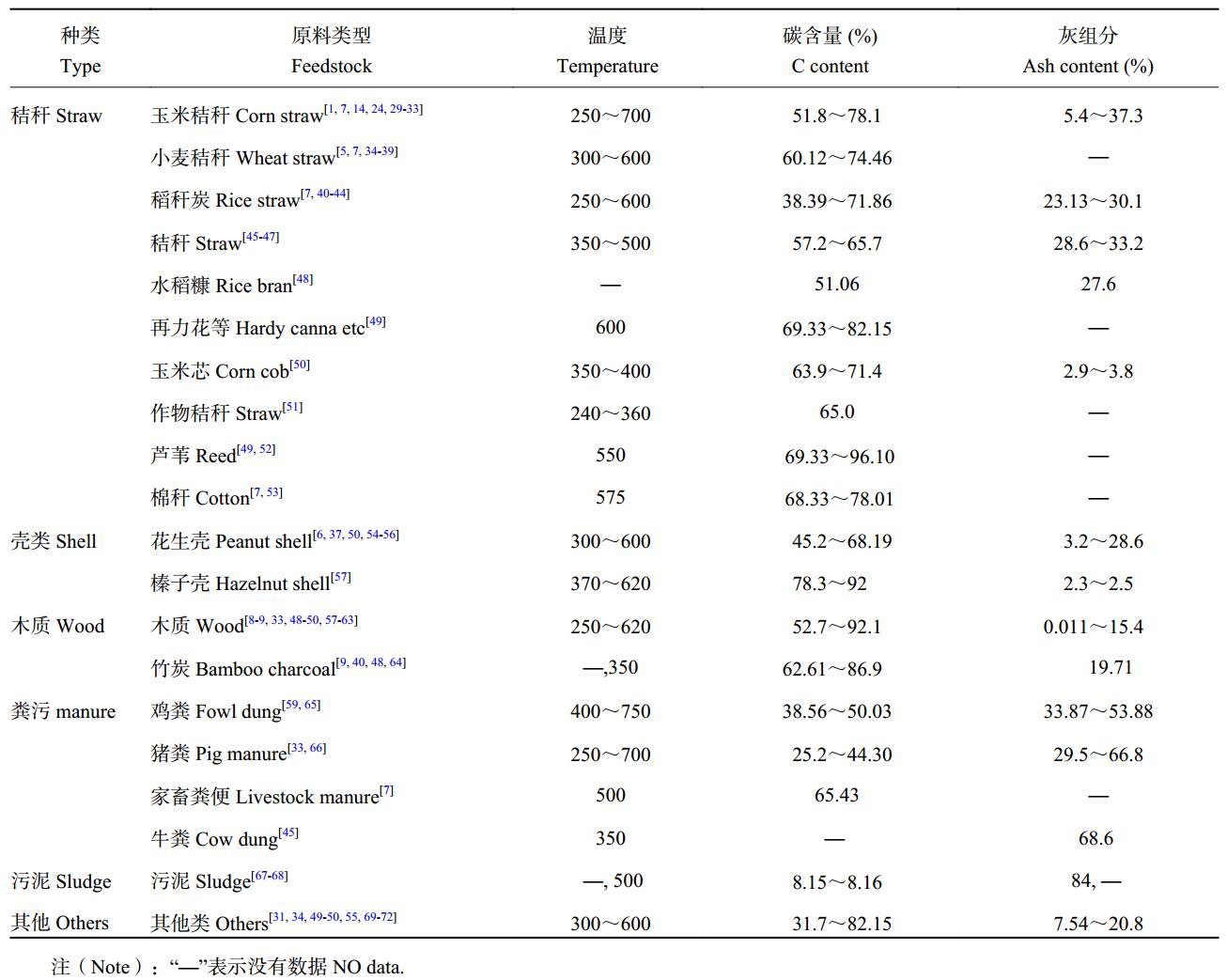 |
如 表 1 所示,不同原料的生物炭其全碳组分和灰组分不同,原材料的种类会影响生物炭的碳组分和灰分。对 119 份生物炭全碳含量进行分析,其范围大多在 30~90% 之间,平均 63.84%,其中秸秆样本数为 41 个、壳类 14 个、木质 42 个、粪污 9 个、污泥 2 个,其他类 11 个。以碳含量中值进行比较,碳含量由大到小分别是木质、秸秆、壳类、粪污和污泥 ( 图 1)。由于原材料性质、裂解工艺、设备、温度和裂解时长以及其他多种复杂不可控客观条件的影响,同一种原料的碳和灰分含量也不同,需要根据生物炭原料性质、生产各环节参数具体分析。
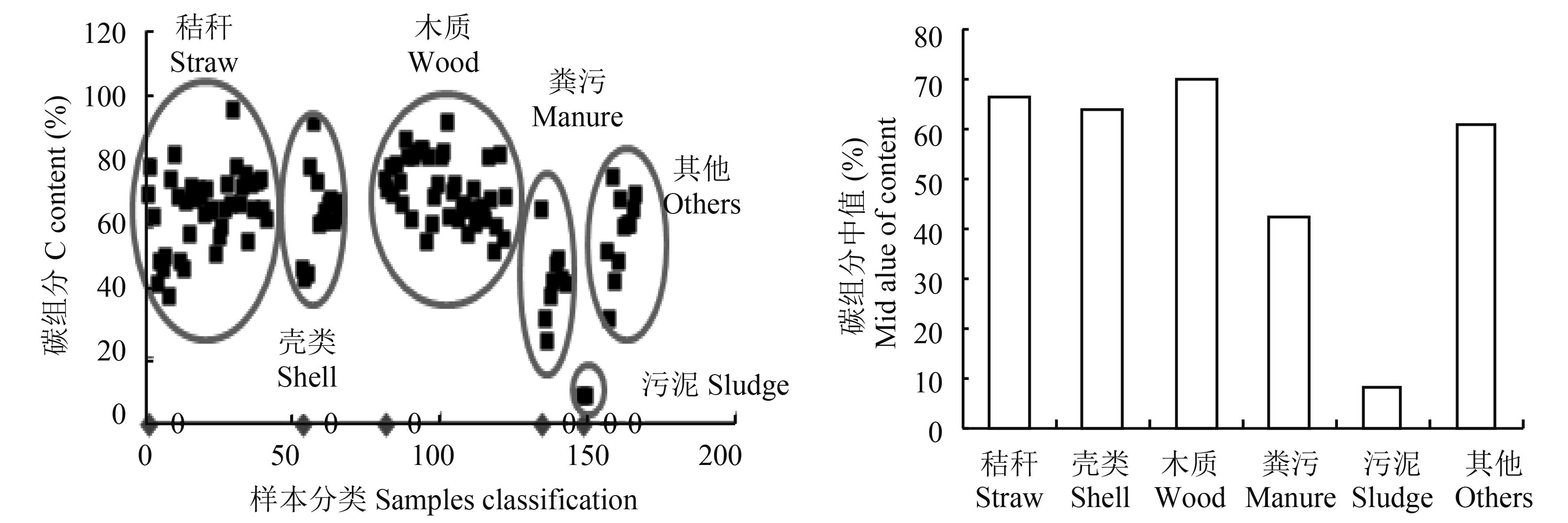 |
| 图1 不同原料生物炭碳含量分布与中值 ( n = 119) Fig. 1 Carbon contents and mid values of biochar from different sources |
对不同原料生物炭碳组分进行频度分析[ 图 2]。结果表明,秸秆生物炭全碳含量在 40%~80% 范围内分布较多;木质生物炭在 60%~85% 范围内分布较广。
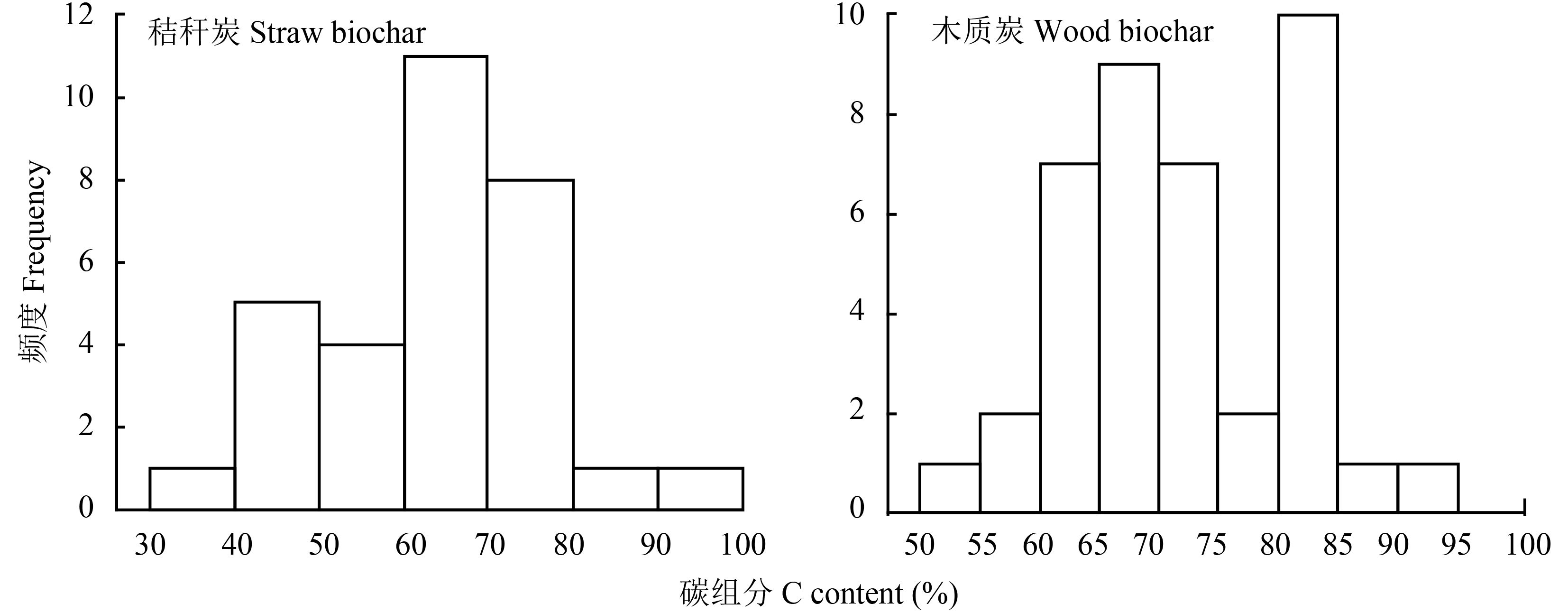 |
| 图2 秸秆和木质生物炭碳组分分布频度 Fig. 2 Frequency of the C contents in straw and wood biochar |
选取总共 82 个生物炭数据 (包括秸秆生物炭 20 个、壳 类 5 个、木质 42 个、粪污 10 个、污泥 1 个及其他类 4 个) 进行灰分含量分析,大多数生物炭灰分含量在 0~40% 之间变动,平均值为 15.52%,只有污泥生物炭灰分含量达到 80% 以上。5 类生物炭灰分含量由大到小分别是污泥、粪污、秸秆、壳类和木质 ( 图 3)。
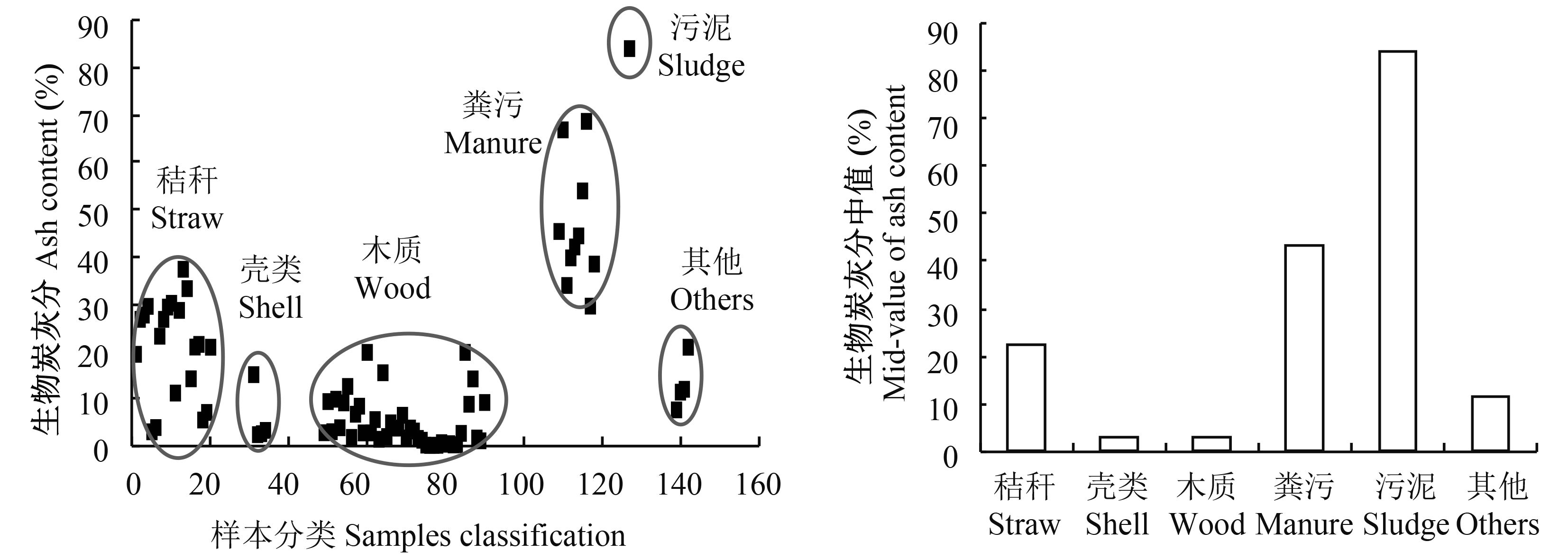 |
| 图3 不同来源生物炭灰分含量分布与中值 ( n = 82) Fig. 3 Ash contents and mid values of biochar from different sources (n = 82) |
选取秸秆和木质生物炭进行灰分频度分析[ 图 4]。结果显示,秸秆生物炭灰分含量多在 20% 至 35%,少量低于 15%;木质碳灰分在 0~10% 范围内分布较多,与木质生物炭含碳量高有关。
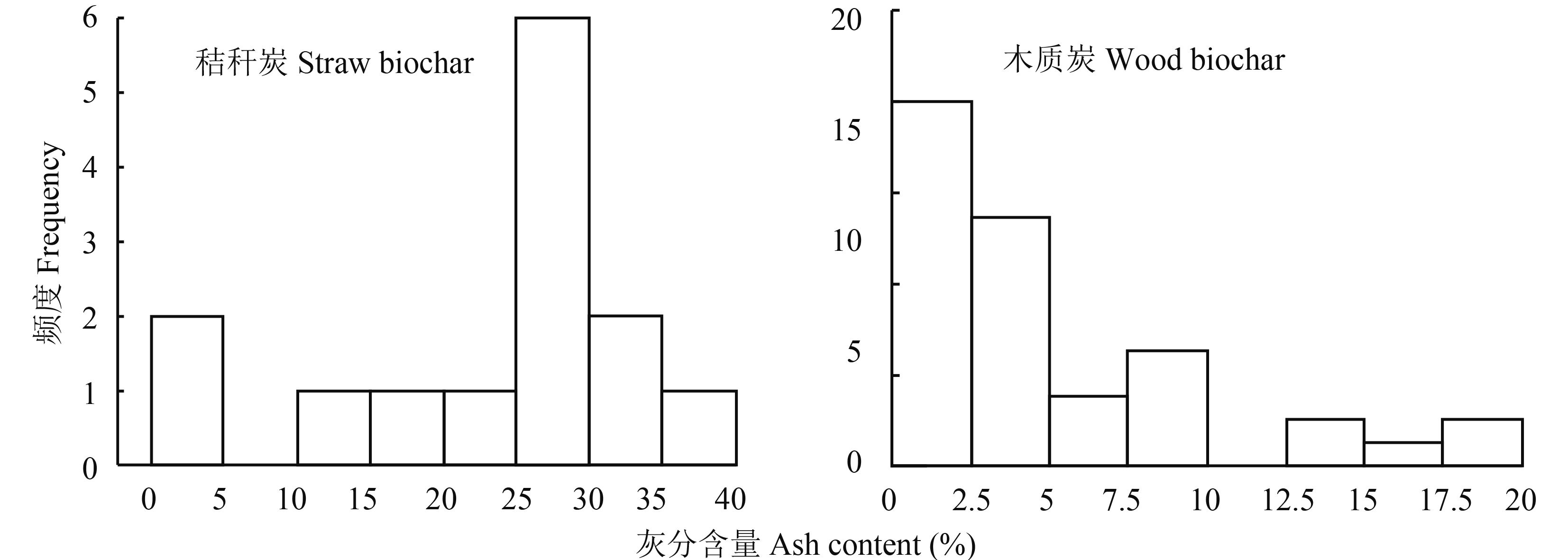 |
| 图4 秸秆和木质生物炭灰分频度 Fig. 4 Frequency of the ash contents in straw and wood biochar |
生物炭的含碳量随炭化温度的不同而发生改变,生物炭性质也受到制备温度、加热速率、通气条件等条件的影响,以温度影响较大。随制备温度的升高,生物炭产量下降,但其碳含量、灰分含量、比表面积以及孔隙度却随着温度的升高而升高。
裂解温度与生物炭碳、灰分含量呈显著正相关,相关系数分别为 0.17 和 0.28。随着裂解温度的升高,生物炭碳含量和灰分含量都增大。生物炭碳含量和灰分含量呈极显著负相关,相关系数为-0.77。因为热裂解温度增高,易热解含碳化合物残留降低,生物炭中难分解碳物质比例相应增高,固定碳含量增大,继而碳含量增多。热裂解温度升高,有机物损失增大,灰分在生物炭中含量相应增大,由 于灰分是碱性物质,生物炭 pH 因生物质热解温度增高而提高。生物炭碳含量高意味着被氧化为无机灰分的部分减少,反之亦然。
1.3 碳组分和灰分含量对土壤的影响施用生物炭可以增加土壤碳素含量,提高土壤碳氮比,改善土壤养分供应状况。黄超等 [ 5] 在肥力较差土壤上施用含碳量为 63.4% 的小麦秸秆生物炭,施用生物质炭量为 10、50 和 200 g/kg 的盆栽黑麦草产量分别比对照增加了 7%、27% 和 53%;句芒芒等 [ 6] 施用碳质量分数为 47.17% 的花生壳生物炭,盆栽番茄产量高达 92746 kg/hm 2;Luo 等研究施入碳含量为 67.69% 的稻秆生物炭发现,可以增加玉米干物质量 [ 7] 。
生物炭灰分含有一定量的矿质养分,污泥、畜禽粪便生物炭比木质、秸秆和壳类生物炭含量更高,可以补充养分贫瘠土壤及沙质土壤的一些养分供应。生物炭灰分量与生物炭 pH 值关系密切,碱性灰分物质高的生物炭 pH 值较高。高海英等 [ 9] 发现,竹炭灰分含量明显高于木炭,矿质养分元素种类和含量也均高于木炭,所以竹炭 pH 值高于木炭。陈心想等 [ 8] 研究发现,施用木质生物炭显著提高了新积土有效磷、钾含量。
2 比表面积 2.1 不同原材料对比表面积的影响热解过程中,生物质原料的结构基本印记在了生物炭中,对生物炭的物理化学性质具有决定性影响 [ 73– 75] 。生物质热解过程中,质量损失 (大部分以挥发有机物的形式) 及不相称的收缩或体积减少的发生,导致矿物及碳骨架形成,并且保留了原料的基本孔隙和结构特征 [ 76] 。生物炭的孔一般按直径大小分为大孔 (ID > 50 nm)、中孔 (2 nm < ID < 50 nm) 和微孔 (ID < 2 nm) [ 75] 。生物炭中保留的植物生物质原料的蜂窝状结构构成了其主要的大孔。微孔主要由热解过程中碳的损失及碳架的断裂收缩形成。虽然大孔可能会作为微孔的前体,但是微孔贡献了生物炭的大部分比表面积,微孔的含量与比表面积呈正相关 [ 77] 。
生物炭的多孔性和低密度性,可改善土壤通气状况,降低厌氧程度。生物炭的大比表面等特性,可以使其具有强的吸附和固定重金属能力 [ 78] 、成为土壤微生物栖息的良好环境 [ 79] 、提高土壤对氮素及其他养分元素吸持容量等 [ 80] 。对不同材料的生物炭比表面积进行分析,得到 表 2。
| 表2 生物炭比表面积 Table 2 Specific surface area of biochar |
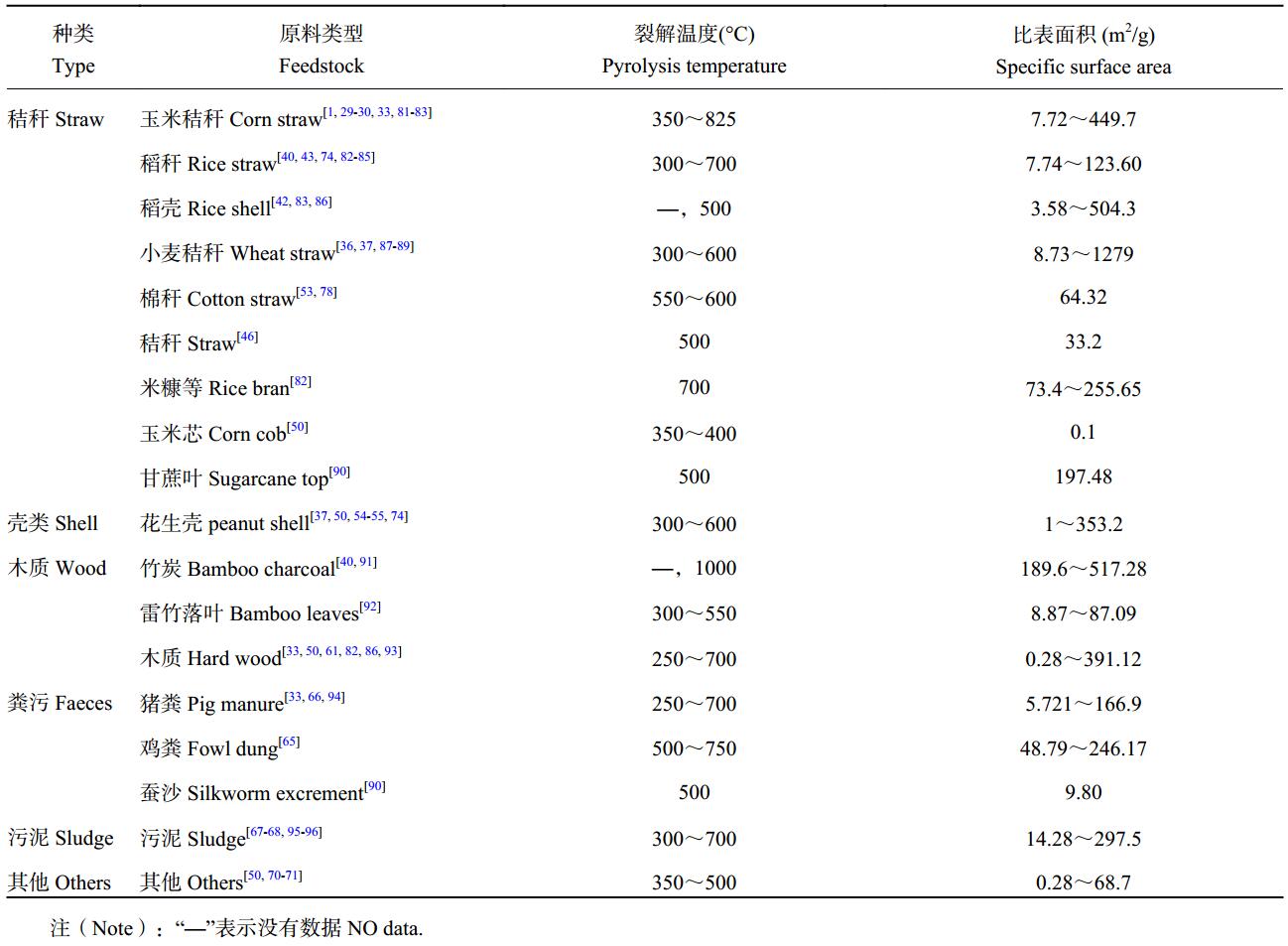 |
不同材料,不同裂解方式对生物炭的比表面积影响很大,有的只有 0.7~15 m 2/g [ 75] ,有的可高达几百个 m 2/g [ 97] ,本研究中生物炭比表面积参数范围与其研究类似,生物炭比表面积的变化范围绝大多数在 0 到 520 m 2/g 之间,平均为 124.83 m 2/g;另外,几类生物炭中,壳类生物炭比表面积中值比其他几类都大,其他依次为粪污、秸秆、木质和污泥,如 图 5。其中,秸秆生物炭样品 36 个、壳类 11 个、木质 17 个、粪污 10 个、污泥 10 个、其他类 9 个,总共 93 个样品。
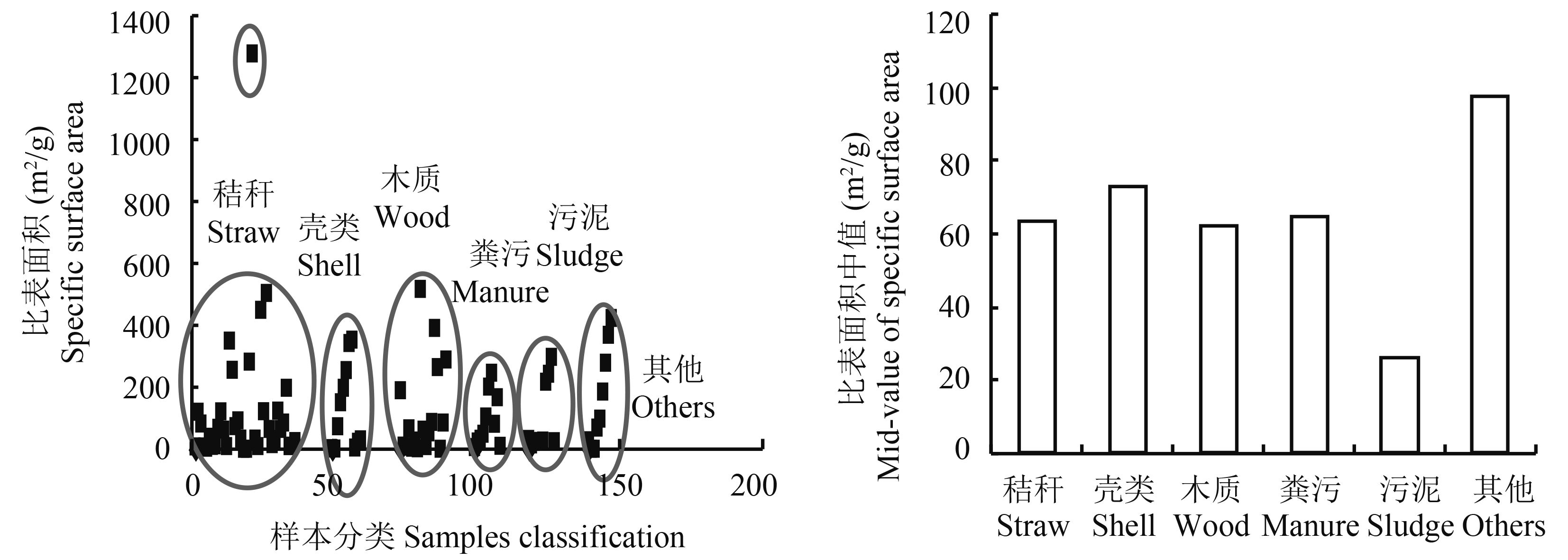 |
| 图5 生物炭比表面积范围示意图 ( n = 93) Fig. 5 Specific surface area of biochar |
生物炭本来就具有多孔隙的性质,数量庞大的微孔隙导致生物炭巨大的表面积。因为裂解温度、原材料种类等因素的变化,致使生物炭的微孔隙数量变化,以至于生物炭比表面积的巨大差距。
对部分种类生物炭的比表面积数据进行频度分析( 图 6)。结果显示,秸秆炭比表面积集中在 0~200 m 2/g 以内,木质炭比表面积集中在 0~100 m 2/g 以内。
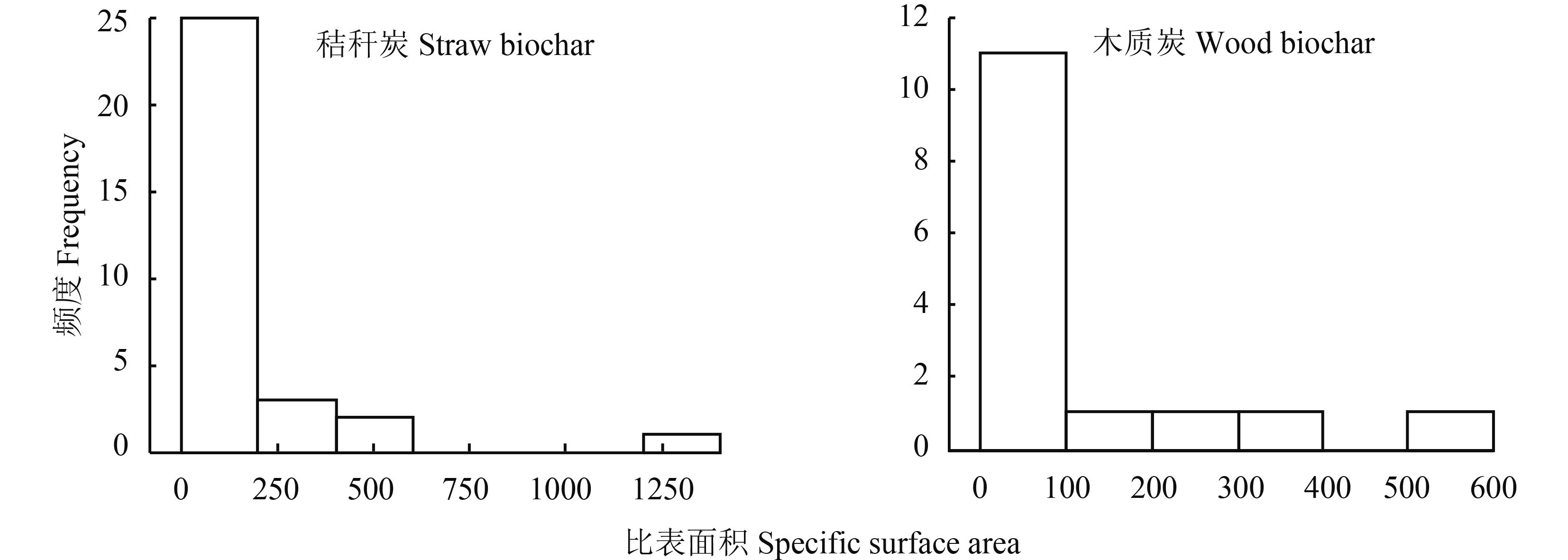 |
| 图6 生物炭比表面积范围频度分析 Fig. 6 Frequency of specific surface area |
研究表明制备温度对生物炭的吸附有很大的影响,因为随着制备温度的升高生物炭的比表面积增大,碳含量增加而氧含量降低,O/C 降低,生物炭的亲水性和极性降低,对水分子的亲和力降低,对疏水性污染物的吸附增强。因此表现为比表面积越大吸附作用越强。
本研究将裂解温度与生物炭比表面积的相关性进行了分析,发现它们呈显著正相关,相关系数为 0.48,即裂解温度的升高可以增加生物炭孔隙度和比表面积,这与之前的研究结论一致。这是因为温度升高,孔结构及复杂性降低,导致比表面积增大。
2.3 比表面积对土壤的影响生物炭具有高的吸附能力。生物炭的孔隙结构能降低土壤容重、降低土壤密度,生物炭具有较大的比表面积和较高表面能,有结合重金属离子的强烈倾向,因此能够较好地去除溶液和钝化土壤中的重金属。李力等 [ 1] 的镉去除实验中 BC350 和 BC700 两种玉米生物炭的比表面积分别为 7.72 m 2/g 和 120 m 2/g,结果显示 BC700 对 Cd (Ⅱ) 的吸附容量大于 BC350,解吸率远小于 BC350,吸附效果更好;刘玉学等 [ 40] 研究比表面积为 81.8 m 2/g、总孔容积为 0.080 cm 3/g 的稻秆炭和比表面积 189.6 m 2/g、总孔容积为 0.175 cm 3/g 的竹炭对小青菜及其土壤的影响,结果显示生物炭的施入能显著降低土壤容重。
3 pH 和 CEC 3.1 不同原材料对 pH 值和 CEC 的影响生物炭的 pH 一般呈碱性,Balwant 等研究发现,生物炭 pH 介于 6.93~10.26 范围之间 [ 28] ,也有研究报道可以制备 pH 介于 4~12 之间的生物炭 [ 98] 。生物炭中无机矿物是造成生物炭 pH 偏碱的主要原因 [ 98– 99] ,生物炭的表面含氧官能团 (如羧基和羟基) 也可能对生物炭的 pH 有一定的贡献。阳离子交换量 (CEC) 是反映生物炭表面负电荷的参数,也决定其在土壤中持留铵、钙和钾等阳离子的能力 [ 26] ,生物炭 CEC 与其表面含氧官能团含量正相关 [ 100] 。现有报道中生物炭的 CEC 差异很大,介于 71 mmol/kg [ 101] 和 34 cmol/kg [ 100– 102] 之间,Balwant 等认为生物炭的 CEC 介于 71.0~451.5 mmol/kg 范围之间 [ 28] 。
本研究中生物炭 pH 值及 CEC 信息如 表 3。对表中生物炭 pH 值信息进行分析得到 图 7。由图 7可以看出,整体上看无论是什么材料的生物炭、裂解温度为多少,生物炭 pH 值范围在 5~12 的范围,平均为 9.15。收集到的 pH 值数据共有 86 个,其中秸秆 41 个、壳类 7 个、木质 25 个、粪污 4 个、污泥 3 个,其他类 6 个,秸秆、污泥、粪污、木质、壳类生物炭 pH 值中值依次递减。
| 表3 生物炭裂解温度、pH 值与 CEC Table 3 Pyrolysis temperature, pH and CEC of biochar |
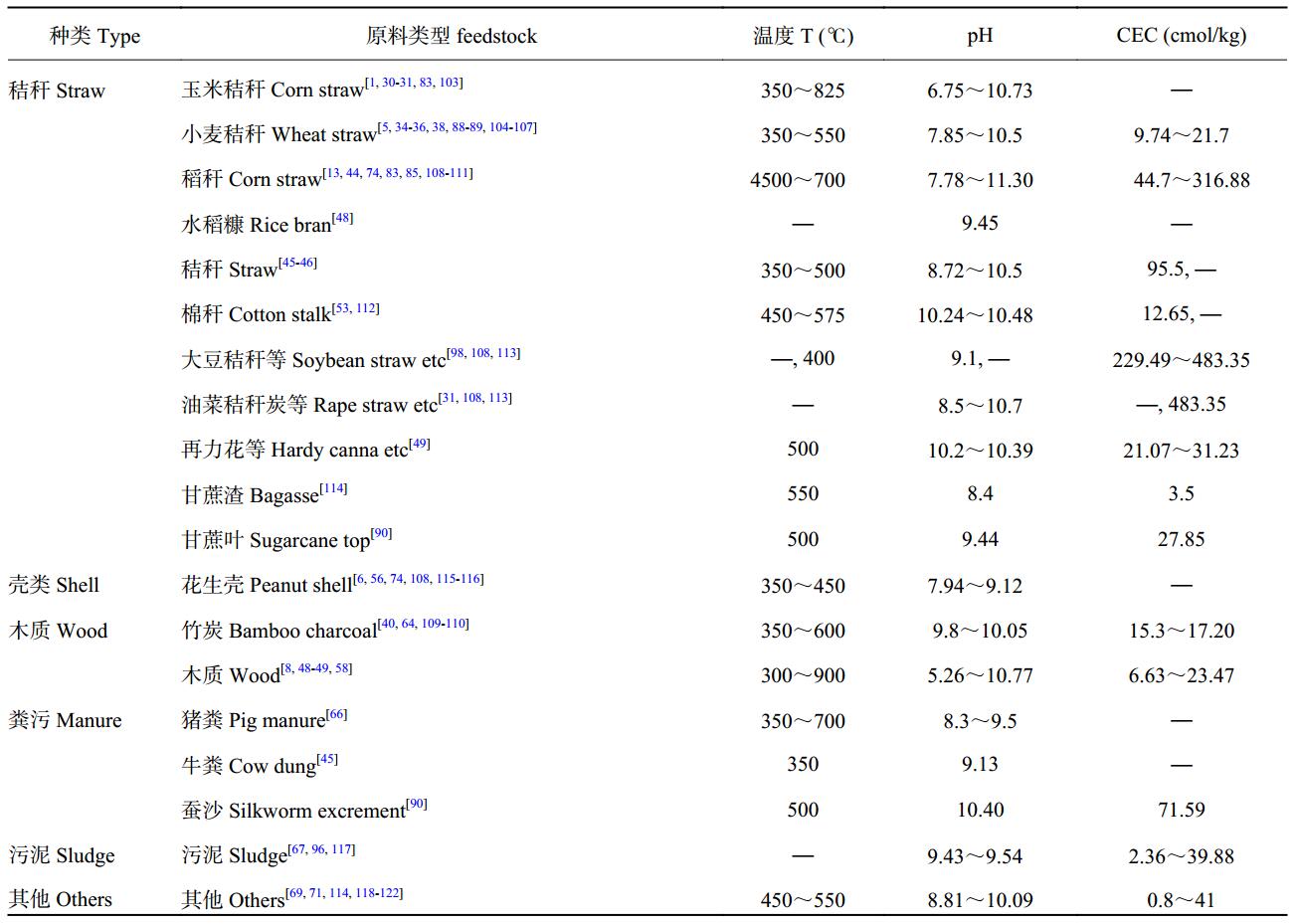 |
 |
| 图7 生物炭 pH 值范围分析 ( n = 86) Fig. 7 pH of biochar from different material |
分析秸秆和木质类生物炭的 pH 值分布频数,得到 图 8。结果表明秸秆生物炭 pH 值多集中在 8~11 范围内;木质生物炭的 pH 分布范围比较广且比较均匀,在 5~11 范围内均有一定数量的分布。
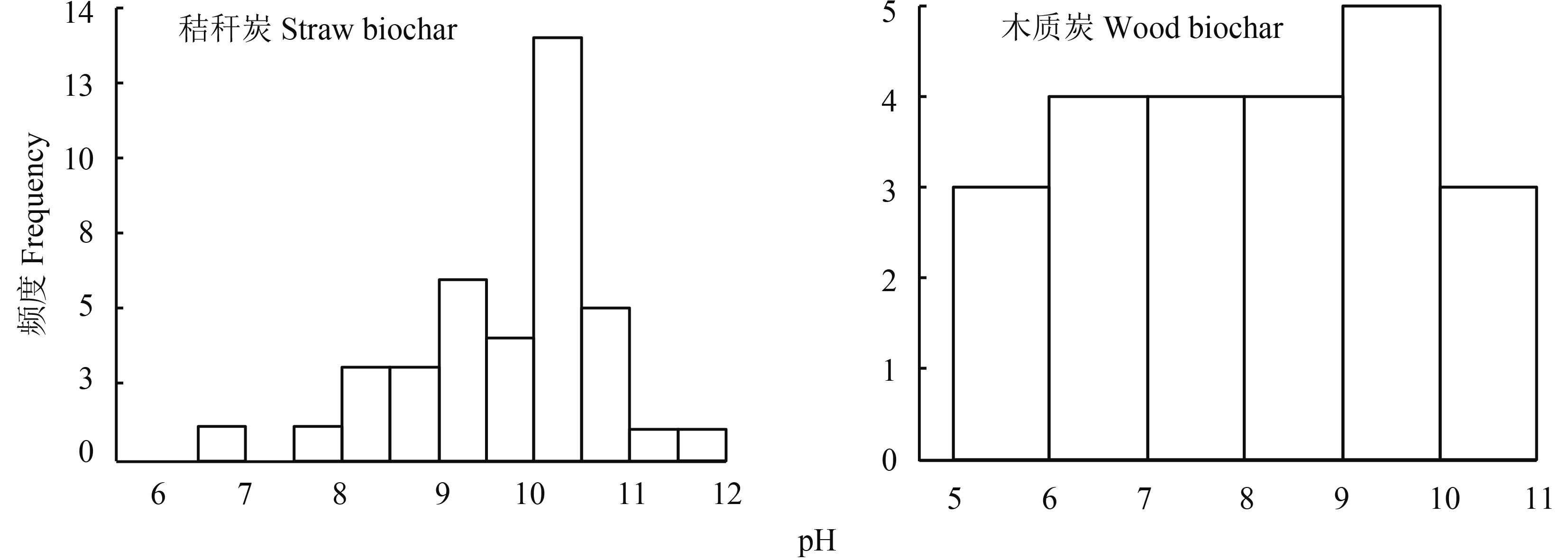 |
| 图8 生物炭 pH 值频度分析 Fig. 8 pH frequency of biochar |
对生物炭的 CEC 进行分析得到 图 9,分析表明生物炭的 CEC 变化范围范围比较大,从 0 到 500 cmol/kg 都有分布,平均为 71.91 cmol/kg。分析数据中秸秆炭 17 个、壳类 1 个、木质 7 个、粪污 1 个、污泥 2 个,其他类 5 个,总共 33 个。CEC 的变化范围比较大,这与生物炭原材料和裂解温度等因素有关。
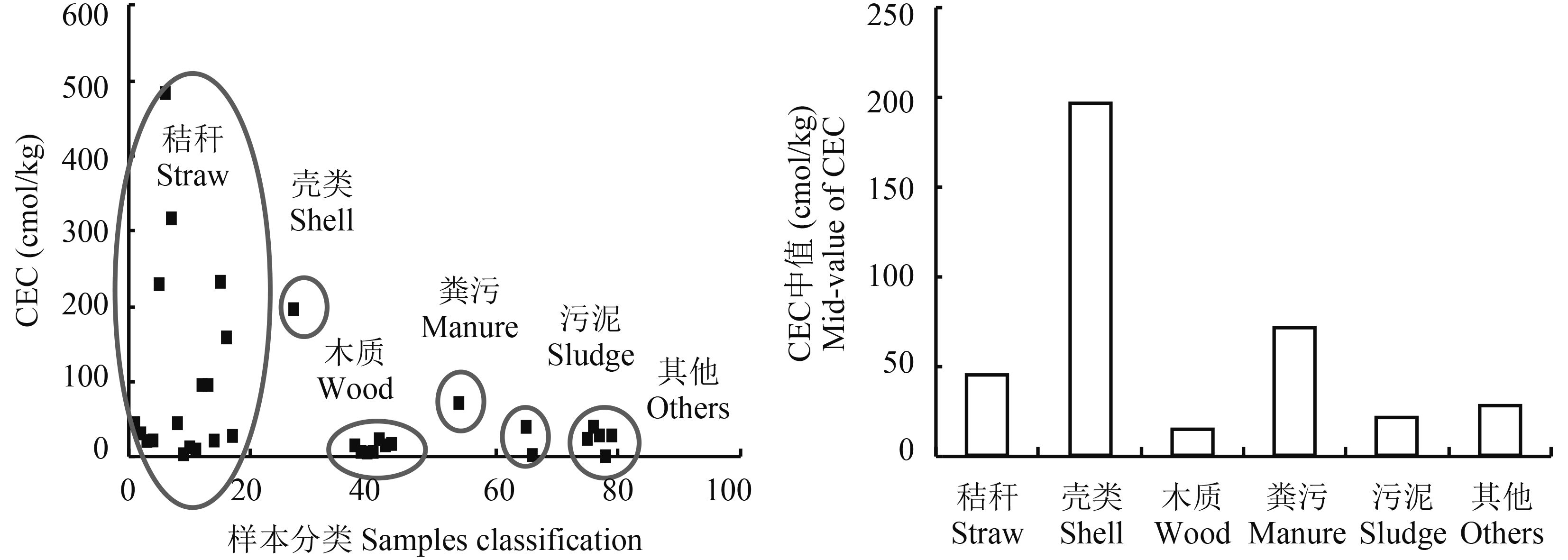 |
| 图9 生物炭 CEC 范围分析 ( n = 33) Fig. 9 CEC of biochar from different materials |
分析秸秆和木质类生物炭的 CEC 分布频数( 图 10),结果表明秸秆生物炭 CEC 值大多集中在 0~100 cmol/kg 范围内;木质生物炭的 CEC 分布范围在 5~10 与 15~25 cmol/kg 范围内均有一定数量的分布。
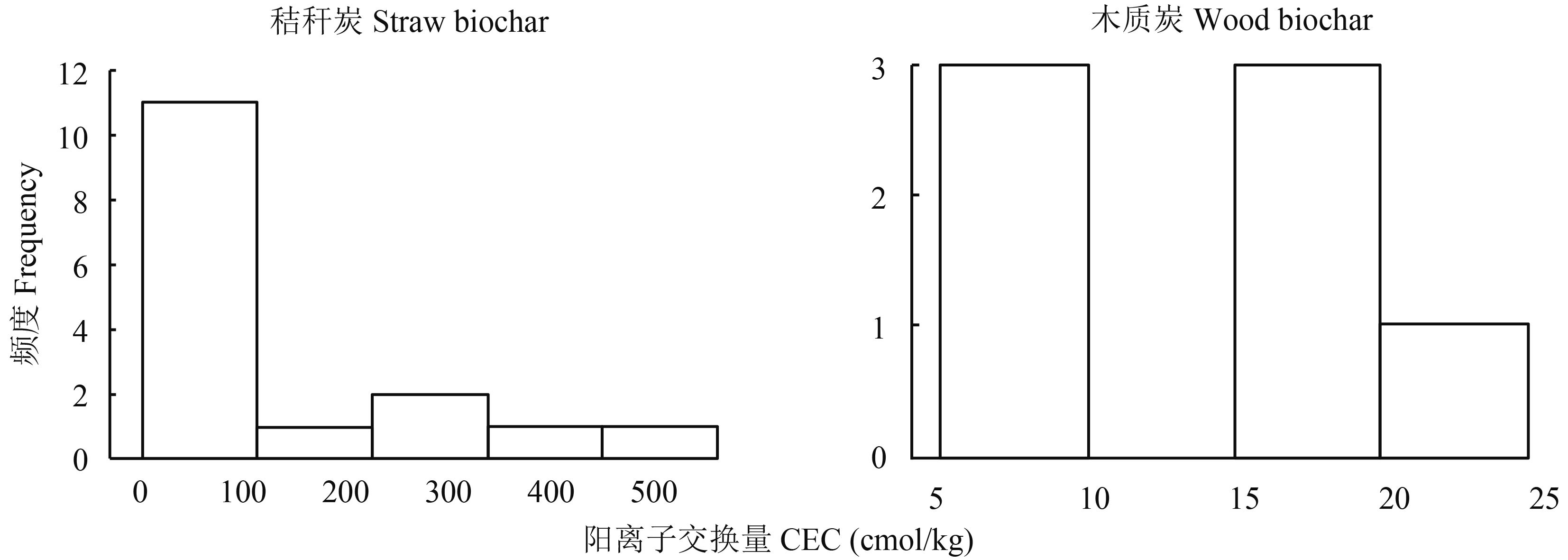 |
| 图10 生物炭 CEC 频度分析 Fig. 10 CEC frequency of biochar |
高温热裂解的生物炭比低温热裂解的生物炭中具有更少的酸性挥发物及更多的灰分,因而 pH 更高。CEC 与生物炭 O/C 比相关,热解温度较低时纤维素分解不完全,含氧官能团如羟基、羧基和羰基被保留,生物炭具有更高的 O/C 比和较大的 CEC。
本研究表明,裂解温度与 pH 值和 CEC 的相关系数为 0.58 和 0.30。即随着裂解温度的升高,生物炭的 pH 值增加,这是因为裂解温度增加了生物炭的灰分含量;裂解温度与生物炭 CEC 呈正相关,这可能是由于过高的裂解温度增加了生物炭的灰分,进而增大了生物炭的 CEC。另外,对 pH 值和 CEC 的相关性进行了分析,结果显示 pH 值和 CEC 呈显著正相关,相关系数为 0.26。生物炭呈碱性,能够明显提高土壤 pH,改变土壤质地,增大盐基交换量,从而引起土壤 CEC 增加,影响植物对营养元素的吸收效果 [ 79, 123] 。
3.3 pH 值和 CEC 对土壤的影响生物炭大多呈碱性,或者具有较大石灰当量值,可以作为石灰替代物,生物炭含大量的有机官能团 (-COO-、-COOH、-O-、-OH 等),能够吸收土壤中的 H +,而其灰分含有的钙、镁、钾、钠等盐基离子可以交换土壤中吸附的氢离子及交换性铝离子,降低土壤中其含量 [ 124] 。因此,可改良酸性土壤一些养分的有效性。黄超等 [ 5] 运用 pH 值为 9.2 的小麦秸秆生物炭研究其对红壤的影响,结果表明红壤施用生物质炭不仅大大提高了土壤碳库,还可降低土壤酸度,增加土壤 pH 值;何飞飞等 [ 74] 研究 pH 值分别为 9.62 和 8.96、BET 比表面积分别为 7.74 m 2/g 和 2.45 m 2/g 的水稻秸秆炭和花生壳炭对红壤菜田土理化性质的影响,结果显示蕹菜收获后,土壤 pH 值、CEC 值和持水量 (WHC) 随生物炭用量增加而升高。
生物炭具有离子吸附交换能力及一定吸附容量,其可改善土壤的阳离子或阴离子交换量,从而可提高土壤的保肥能力。生物炭对土壤阳离子交换量 CEC 或保肥能力的改善取决于生物炭的 CEC,pH 及生物炭在土壤中氧化。生物炭比表面积大,可以增强土壤对阳离子的吸附能力,增加耕层土壤 CEC。生物炭对低 CEC 和 pH 的酸性土壤中的 CEC 改良特别有效,其中土壤 CEC 的改良与生物炭的原料的碱度、有机氮的矿化和铵根的硝化作用有关 [ 125] 。生物炭的 pH 升高,其对重金属离子的吸附和固定加强,说明了生物炭对重金属的吸附与生物炭的表面官能团和 pH 值有关 [ 124, 126] 。
4 问题与展望在查阅的 100 多篇文献中,分别得到碳组分、灰分、比表面积、pH 值和 CEC 几种参数数据 119、82、93、86、33 个,反映出目前生物炭理化特性研究者对这几大参数重视程度不一,这与裂解材料的来源、实验成本、实验复杂性以及研究方向有直接关系。另外,在裂解温度方面,Balwant 等的研究认为生物炭裂解温度在 100℃ 至 900℃ 范围内 [ 28] ;本研究表明,生物炭的裂解温度大都集中在 200℃ 至 800℃ 之间,偶有达到 1000℃ 的裂解温度。
生物炭的研究是最近几年才出现在人们视野中的新兴研究领域,虽然国内外专家学者已经做了大量关于生物炭原材料、性状、对土壤效应以及作用机理等多方面的研究,但是全世界范围内对生物炭的生产和使用还处于就近和来源方便的初级阶段,影响着生物炭功能和效益的最大化。从生物炭的裂解原料、裂解工艺、裂解设备,及生物炭对土壤、作物、重金属、有机污染物及碳循环等的作用效果,再到生物炭作用机理的整个产业链的研究 (甚至各个环节相互影响的研究),都还只是比较分散、零散的研究堆积,并没有形成系统的、全面的生物炭研究体系,对生物炭的生产、应用还没有成熟理论的指导,尤其是生物炭理化性状参数的研究。生物炭的理化性质直接反映其原材料、生产水平和后端应用等。比如目前还没有非常详实和确定的论据来证明生物炭的何种性状对土壤或者作物的何种效应作用最大,对于生物炭的理化参数最优范围仍然没有确定值,比如生物炭灰分能增加土壤 pH 值,究竟何种类型生物炭含有多少灰分能在多大程度上增加 pH 值?玉米秸秆生物炭比表面积为多少时可以吸附 Cd 的量为多少等等。另外,不同生物炭的应用还处于探索阶段,功效不能有效发挥。并且应用研究大多针对单一类型生物炭,缺乏不同原料生物炭的选配和组合研究。综上所述,未来应从以下几个方面加强研究和应用试验。首先,系统研究生物炭制造参数对理化性状的影响,研究不同原料生物炭的作用机理差异及其针对性,建立生物炭理化性质参数数据库,生物炭理化性质参数数据库的建立十分必要,这对于生物炭详细参数的研究和相关标准的制定具有指导意义,需要广大专家学者一同努力;其次,加强应用研究,根据土壤理化性状和改良目标选择适宜的生物炭类型,根据对作物经济性状的要求,研究选择适宜的生物炭类型,实现生物炭功效的最大利用。再次,加强不同原料的选配和组合研究,改良生物炭产品的目标性状,形成系列化产品。
| [1] |
李力, 陆宇超, 刘娅, 等. 玉米秸秆生物炭对Cd(Ⅱ)的吸附机理研究[J].
农业环境科学学报, 2012, 31 (11) : 2277 –2283.
Li L, Lu Y C, Liu Y, et al. Adsorption Mechanisms of Cadmium(Ⅱ)on Biochars Derived from Corn Straw[J]. Journal of Agro-Environment Science, 2012, 31 (11) : 2277 –2283. |
| [2] | Braida W J, Pignatello J J, Lu Y F, et al. Sorption hysteresis of benzene in charcoal particles[J]. Environmental Science & Technology, 2003, 37 : 409 –417. |
| [3] | Kramer R W, Kujawinski E B, Hatcher P G. Identification of black carbon derived structures in a volcanic ash soil humic acid by Fourier transformation cyclotron resonance mass spectrometry[J]. Environmental Science & Technology, 2004, 38 : 3387 –3395. |
| [4] |
王摇, 侯艳伟, 彭静静, 等. 生物炭吸附有机污染物的研究进展[J].
环境化学, 2012, 31 (3) : 287 –295.
Wang N, Hou Y W, Peng J J, et al. Research progress on sorptionof orgnic contaminants to biochar[J]. Environmental Chemistry, 2012, 31 (3) : 287 –295. |
| [5] |
黄超, 刘丽君, 章明奎. 生物质炭对红壤性质和黑麦草生长的影响[J].
浙江大学学报:农业与生命科学版, 2011, 37 (4) : 439 –445.
Huang C, Liu L J, Zhang M K. Effects of biochar on properties of red soil and ryegrass growth[J]. Journal of Zhejiang University (Agric. &Life Sci.), 2011, 37 (4) : 439 –445. |
| [6] |
勾芒芒, 屈忠义. 土壤中施用生物炭对番茄根系特征及产量的影响[J].
生态环境学报, 2013, 22 (8) : 1348 –1352.
Gou M M, Qu Z Y. Effect of biochar on root distribution and yield of tomato in sandy loam soil[J]. Ecology and Environmental Sciences, 2013, 22 (8) : 1348 –1352. |
| [7] | Luo Y, Jiao Y J, Zhao X R, et al. Improvement to maize growth caused by biochars derived from six feedstocks prepared at three different temperatures[J]. Journal of Integrative Agriculture, 2014, 13 (3) : 533 –540. |
| [8] |
陈心想, 何绪生, 耿增超, 等. 生物炭对不同土壤化学性质、小麦和糜子产量的影响[J].
生态学报, 2013, 33 (20) : 6534 –6542.
Chen X X, He X S, Geng Z C, et al. Effcts of biochar on selected soil chemical properties and on wheat and millet yield[J]. Acta Ecologica Sinca, 2013, 33 (20) : 6534 –6542. |
| [9] |
高海英, 陈心想, 张雯, 等. 生物炭和生物炭基氮肥的理化特征及其作物肥效评价[J].
西北农林科技大学学报(自然科学版), 2013, 41 (4) : 69 –85.
Gao H Y, Chen X X, Zhang W, et al. Physicochemical properties and efficiences of biochar and biochar-based nitrogenous fertilizer[J]. Journal of Northwest A and F University (Nat.Sci.Ed), 2013, 41 (4) : 69 –85. |
| [10] | Saran S, Elisa L C, Evelyn K, et al. Biochar, climate change and soil:a review to guide future research[R]. CSIRO Land and Water Science Report, 2009:5-6. |
| [11] | 章明奎, 王浩, 郑顺安, 等. 土壤中黑碳的表面化学性质及其变化研究[J]. 浙江大学学报(农业与生命科学版), 2009, 35 (3) : 278 –284. |
| [12] |
袁金华, 徐仁扣. 生物质炭的性质及其对土壤环境功能影响的研究进展[J].
生态环境学报, 2011, 20 (4) : 779 –785.
Yuan J H, Xu R K. Progress of the research on the properties of biochars and their influence on soil environmental functions[J]. Ecology and Environmental Sciences, 2011, 20 (4) : 779 –785. |
| [13] |
刘玉学, 刘微, 吴伟祥, 等. 土壤生物炭环境行为与环境效应[J].
应用生态学报, 2009, 20 (4) : 977 –982.
Liu Y X, Liu W, Wu W X, et al. Environmental behavior and effect of biomass-derived black carbon in soil[J]. Chinese Journal of Applied Ecology, 2009, 20 (4) : 977 –982. |
| [14] |
李力, 刘娅, 陆宇超, 等. 生物炭的环境效应及其应用的研究进展[J].
环境化学, 2011, 30 (8) : 1411 –1421.
Li L, Liu Y, Lu Y C, et al. Review on environmental effects and applications of biochar[J]. Environmental Chemistry, 2011, 30 (8) : 1411 –1421. |
| [15] |
张文玲, 李桂花, 高卫东. 生物质炭对土壤性状和作物产量的影响[J].
中国农学通报, 2009, 25 (17) : 153 –157.
Zhang W L, Li G H, Gao W D. Effects of biomass charcoal on soil character and crop yield[J]. Chinese Agricultural Science Bulletin, 2009, 25 (17) : 153 –157. |
| [16] |
何绪生, 耿增超, 佘雕, 等. 生物炭生产与农用的意义及国内外动态[J].
农业工程学报, 2011, 27 (2) : 1 –7.
He X S, Geng Z C, She D, et al. Implications of production and agricultural utilization of biochar and its international dynamics[J]. Transactions of the CSAE, 2011, 27 (2) : 1 –7. |
| [17] |
张阿凤, 潘根兴, 李恋卿.
生物黑炭及其增汇减排与改良土壤意义. 农业环境科学学报[M]. 2009 : 2459 -2463.
Zhang X S, Pan G X, Li L Q. Biochar and the effect on C stockenhancement, emission reduction of greenhouse gases and soil reclaimation. Journal of Agro-Enviroment Science[M]. 2009 : 2459 -2463. |
| [18] |
潘根兴, 张阿凤, 邹建文, 等. 农业废弃物生物黑炭转化还田作为低碳农业途径的探讨[J].
生态与农村环境学报, 2010, 26 (4) : 394 –400.
Pan G X, Zhang A F, Zou J W. Biochar from agro-byproducts used as amendment to croplands:an option for low carbon agriculture[J]. Journal of Ecology and Rural Environment, 2010, 26 (4) : 394 –400. |
| [19] |
张旭东, 梁超, 诸葛玉平, 等. 黑碳在土壤有机碳生物地球化学循环中的作用[J].
土壤通报, 2003, 34 (4) : 349 –355.
Zhang X D, Liang C, Zhuge Y P, et al. Roles of black carbon in the biogeochemical cycles of organic carbon[J]. Chinese Academy of Sciences, 2003, 34 (4) : 349 –355. |
| [20] |
韩永明, 曹军骥. 环境中的黑碳及其全球生物地球化学循环[J].
海洋地质与第四纪地质, 2005, 25 (1) : 125 –132.
Han Y M, Cao J J. Black carbon in the environments and its global biogeochemical cycle[J]. Marine Geology and Quaternary Geology, 2005, 25 (1) : 125 –132. |
| [21] | Joseph S, Peacocke C, Lehmann J, Munroe P. Developing a biochar classification system and test methods[A]. Lehmann J, Joseph S. Biochar for environmental management. London, UK: Earthscan[M]. 2009 : 107 -126. |
| [22] | Amonette J E, Joseph S. Characteristics of biochar:Microchemical properties[J]. Journal of the Party School of Shengli Oilfield, 2013, 7 (6) : 1649 –1654. |
| [23] | Keiluweit M, Nico P S, Johnson M G, et al. Dynamic molecular structure of plant biomass-derived black carbon (biochar)[J]. Environmental Science & Technology, 2010, 44 (4) : 1247 –1253. |
| [24] | Spokas K A. Review of the stability of biochar in soils:predictability of O:C molar ratios[J]. Carbon Management, 2010, 1 (2) : 289 –303. |
| [25] | Spokas K A, Cantrell K B, Novak J M, et al. Biochar:a synthesis of its agronomic impact beyond carbon sequestration[J]. Journal of Environmental Quality, 2012, 41 (4) : 973 –989. |
| [26] | Mukherjee A. Physical and chemical properties of a range of laboratory-produced fresh and aged biochars[D]. Gainesville, FL, USA:Ph.D Dissertation of University of Florida, 2011. |
| [27] | Cao X D, Ma L N, Gao B, et al. Dairy-manure derived biochar effectively sorbs lead and atrazine[J]. Environmental Science & Technology, 2009, 43 (9) : 3285 –3291. |
| [28] | Balwant S, Bhupinder P S, Annette L. Characterisation and evaluation of biochars for their application as a soil amendment[J]. Australian Journal of Soil Research, 2010, 48 : 516 –525. |
| [29] |
李明遥, 张妍, 杜立宇, 等. 生物炭与沸石混施对土壤Cd形态转化的影响[J].
水土保持学报, 2014, 28 (3) : 248 –252.
Li M Y, Zhang Y, Du L Y, et al. Influence of biochar and zeolite on the fraction transform of cadmium in contaminated soil[J]. Journal of Soil and Water Conservation, 2014, 28 (3) : 248 –252. |
| [30] |
高德才, 张蕾, 刘强, 等. 旱地土壤施用生物炭减少土壤氮损失及提高氮素利用率[J].
农业工程学报, 2014, 30 (6) : 54 –61.
Gao D C, Zhang L, Liu Q, et al. Application of biochar in dryland soil decreasing loss of nitrogen and improving nitrogen using rate[J]. Transactions of the CSAE, 2014, 30 (6) : 54 –61. |
| [31] |
张晶, 苏德纯. 不同镉污染农田土壤上秸秆和炭化秸秆分解动态及其对土壤镉的吸附特征[J].
环境工程学报, 2013, 7 (10) : 4097 –4012.
Zhang J, Su D C. Decompositiom dynamic and Cd adsorption characteristic of crop straw and biochar in different Cd-contaminated farmland soils[J]. Chinese Journal of Environmental Engineering, 2013, 7 (10) : 4097 –4012. |
| [32] |
黄华, 王雅雄, 唐景春, 等. 不同烧制温度下玉米秸秆生物炭的性质及对萘的吸附性能[J].
环境科学, 2014, 35 (5) : 1884 –1890.
Huang H, Wang Y R, Tang J C, et al. Properties of maize stalk biochar produced under different pyrolysis temperatures and its sorption capability to naphthalene[J]. Environmental Science, 2014, 35 (5) : 1884 –1890. |
| [33] |
颜钰, 王子莹, 金洁, 等. 不同生物质来源和热解温度条件下制备的生物炭对菲的吸附行为[J].
农业环境科学学报, 2014, 33 (9) : 1810 –1816.
Yan Y, Wang Z Y, Jin J, et al. Phenanthrene adsorption on biochars produced from different biomass materials at two temperatures[J]. Journal of Agro-Environment Science, 2014, 33 (9) : 1810 –1816. |
| [34] |
张晗芝, 黄云, 刘钢, 等. 生物炭对玉米苗期生长、养分吸收及土壤化学性状的影响[J].
生态环境学, 2010, 19 (11) : 2713 –2717.
Zhang H Z, Huang Y, Liu G, et al. Effects of biochar on corn growth, nutrient uptake and soil chemical properties in seeding stage[J]. Ecology and Environmental Sciences, 2010, 19 (11) : 2713 –2717. |
| [35] | Cheng Y, Cai Z C, Scott X, et al. Wheat straw and its biochar have contrasting effects on inorganic N retention and N2O production in a cultivated Black Chernozem[J]. Biology and Fertility of Soils, 2012, 48 : 941 –946. |
| [36] |
王荣梅, 杨放, 许亮, 等. 生物炭在新疆棉田的应用效果研究[J].
地球与环境, 2014, 42 (6) : 757 –763.
Wang R F, Yang F, Xu L, et al. The effects of biochar application in the cotton fields of Kashgar Oasis, Xinjiang Uygur Autonomous Region, China[J]. Earth and Environment, 2014, 42 (6) : 757 –763. |
| [37] |
郎印海, 刘伟, 王慧. 生物炭对水中五氯酚的吸附性能研究[J].
中国环境科学, 2014, 34 (8) : 2017 –2023.
Lang Y H, Liu W, Wang H, et al. Adsorption efficiencies of pentachlorophenol from aqueous solution onto biochars[J]. China Environmental Science, 2014, 34 (8) : 2017 –2023. |
| [38] |
张娜, 李佳, 刘学欢, 等. 生物炭对夏玉米生长和产量的影响[J].
农业环境科学学报, 2014, 33 (8) : 1569 –1574.
Zhang N, Li J, Liu X H, et al. Effects of biochar on growth and yield of summer maize[J]. Journal of Agro-Environment Science, 2014, 33 (8) : 1569 –1574. |
| [39] |
蒋旭涛, 迟杰. 铁改性生物炭对磷的吸附及磷形态的变化特征[J].
农业环境科学学报, 2014, 33 (9) : 1817 –1822.
Jiang X T, Chi J. Phosphorus adsorption by and forms in fe-modified biochar[J]. Journal of Agro-Environment Science, 2014, 33 (9) : 1817 –1822. |
| [40] |
刘玉学, 王耀锋, 吕豪豪, 等. 不同稻秆炭和竹炭施用水平对小青菜产量、品质以及土壤理化性质的影响[J].
植物营养与肥料学报, 2013, 19 (6) : 1438 –1444.
Liu Y X, Wang Y F, Lv H H, et al. Effcts of different application rates of rice straw biochar and bamboo biochar on yield and quality of greengrocery (Brassica chinensis) and soil properties[J]. Journal of Plant Nutrition and Fertilizer, 2013, 19 (6) : 1438 –1444. |
| [41] | Yin Y F, He X H, Gao R, et al. Effects of rice straw and its biochar addition on soil labile carbon and soil organic carbon[J]. Journal of Integrative Agriculture, 2014, 13 (3) : 491 –498. |
| [42] | Han X, Liang C H, Li T Q, et al. Simultaneous removal of cadmium and sulfamethoxazole from aqueous solution by rice straw biochar[J]. Journal of Zhejiang University-Science B (Biomedicine & Biotechnology), 2013, 14 (7) : 640 –649. |
| [43] |
安增莉, 侯艳伟, 蔡超, 等. 水稻秸秆生物炭对Pb(Ⅱ)的吸附特性[J].
环境化学, 2011, 30 (11) : 1851 –1857.
Adsorption characteristics on different biochars derived from rice straw[J]. Adsorption characteristics on different biochars derived from rice straw[J]. Environmental Chemistry, 2011, 30 (11) : 1851 –1857. |
| [44] |
惠锦卓, 张爱平, 刘汝亮, 等. 添加生物炭对灌淤土土壤养分含量和氮素淋失的影响[J].
中国农业气象, 2014, 35 (2) : 156 –161.
Hui J Z, Zhang A P, Liu R L, et al. Effects of biochar on soil nutrients and nitrogen leaching in anthropogenic-alluvial soil[J]. Chinese Journal of Agrometeorology, 2014, 35 (2) : 156 –161. |
| [45] |
梁媛, 李飞跃, 杨帆, 等. 含磷材料及生物炭对复合重金属污染土壤修复效果与修复机理[J].
农业环境科学学报, 2013, 32 (12) : 2377 –2383.
Liang Y, Li F Y, Yang F, et al. Immobilization and its mechanisms of heavy metal contaminated soils by phosphate-containing amendment and biochar[J]. Journal of Agro-Environment Science, 2013, 32 (12) : 2377 –2383. |
| [46] |
杨帆, 李飞跃, 赵玲, 等. 生物炭对土壤氨氮转化的影响研究[J].
农业环境科学学报, 2013, 32 (5) : 1016 –1020.
Yang F, Li F Y, Zhao L, et al. Influence of biochar on the transformation of ammonia nitrogen in soils[J]. Journal of Agro-Environment Science, 2013, 32 (5) : 1016 –1020. |
| [47] |
陈红霞, 杜章留, 郭伟, 等. 施用生物炭对华北平原农田土壤容重、阳离子交换量和颗粒有机质含量的影响[J].
应用生态学报, 2011, 22 (11) : 2930 –2934.
Chen H X, Du Z L, Guo W, et al. Effects of biochar amengment on cropland soil bulk density, cation exchange capacity, and particulate organic matter content in the North China Plain[J]. Chinese Journal of Applied Ecology, 2011, 22 (11) : 2930 –2934. |
| [48] | Zhang J N, Lu F, Luo C H, et al. Humification characterization of biochar and its potential as a composting amendment[J]. Journal of Environmental Sciences, 2014, 26 : 390 –397. |
| [49] | Zeng Z, Zhang S D, Li T Q, et al. Sorption of ammonium and phosphate from aqueous solution by biochar derived from phytoremediation plants[J]. Journal of Zhejiang University-Science B (Biomedicine & Biotechnology), 2013, 14 (12) : 1152 –1161. |
| [50] | Kurt A S, John M B, Donald C R. Ethylene:potential key for biochar amendment impacts[J]. Plant and Soil, 2010, 333 : 443 –452. |
| [51] |
李际会, 吕国华, 白文波, 等. 改性生物炭的吸附作用及其对土壤硝态氮和有效磷淋失的影响[J].
中国农业气象, 2012, 33 (2) : 220 –225.
Li J H, Lü G H, Bai W B, et al. Effect of Modified Biochar on Soil Nitrate Nitrogen and Available Phosphorus Leaching[J]. Chinese Journal of Agrometeorology, 2012, 33 (2) : 220 –225. |
| [52] |
刘鸿骄, 侯亚红, 王磊. 秸秆生物炭还田对围垦盐碱土壤的低碳化改良[J].
环境科学与技术, 2014, 37 (1) : 75 –80.
Liu H J, Hou Y H, Wang L. Amelioration effect of reed straw biochar returning to salty soil in the view of low carbon point[J]. Environmental Science and Technology, 2014, 37 (1) : 75 –80. |
| [53] |
王林, 徐应明, 梁学峰, 等. 生物炭和鸡粪对镉低积累油菜吸收镉的影响[J].
中国环境科学, 2014, 34 (11) : 2851 –2858.
Wang L, Xu Y M, Liang X F, et al. Effects of biochar and chicken manure on cadmium uptake in pakchoi cultivars with low cadmium accumulation[J]. China Environment Science, 2014, 34 (11) : 2851 –2858. |
| [54] |
乌英嗄, 张贵龙, 赖欣, 等. 生物炭施用对华北潮土土壤细菌多样性的影响[J].
农业环境科学学报, 2014, 33 (5) : 965 –971.
Wu Y G, Zhang G L, Lai X, et al. Effects of biochar applications on bacterial diversity in fluvor-aquic soil of North China[J]. Journal Of Agro-Environment Science, 2014, 33 (5) : 965 –971. |
| [55] |
王震宇, 刘国成, MonicaX, 等. 不同热解温度生物炭对Cd(Ⅱ)的吸附特性[J].
环境科学, 2014, 35 (12) : 4735 –4744.
. varies with biochars derived at different pyrolysis temperatures[J]. Environmental Science, 2014, 35 (12) : 4735 –4744. |
| [56] |
李冬, 陈蕾, 夏阳, 等. 生物炭改良剂对小白菜生长及低质土壤氮磷利用的影响[J].
环境科学学报, 2014, 34 (9) : 2384 –2391.
Li D, Chen L, Xia Y, et al. The effects of biochar on growth and uptake of nitrogen and phosphorus for Chinese cabbage in poor quality soil in Ningxia[J]. Acta Science Circumstantiae, 2014, 34 (9) : 2384 –2391. |
| [57] | Will F, Myles G, Fredrick P, et al. A simple technique to eliminate ethylene emissions from biochar amendment in agriculture[J]. Agronomy for Sustainable Development, 2013, 33 : 469 –474. |
| [58] |
孟李群, 张云鹏, 苏漳文, 等. 不同炭化温度下杉木生物炭产率及特性比较[J].
福建林业科技, 2014, 41 (2) : 38 –41.
Meng L Q, Zhang Y P, Su Z W, et al. Comparison of Chinese fir biochar carbon yield and characteristics at different carbonization temperatures[J]. Journal of Fujian Forestry Science and Technology, 2014, 41 (2) : 38 –41. |
| [59] |
侯艳伟, 曾月芬, 安增莉. 生物炭施用对污染红壤中重金属化学形态的影响[J].
内蒙古大学学报(自然科学版), 2011, 42 (4) : 460 –466.
Hou Y W, Zeng Y F, An Z L. Effcets of the Application of Biochar on the Chemical Fraction of Heavy Metals in Polluted Red Soil[J]. Journal of Inner Mongolia University(Natural Science Edition), 2011, 42 (4) : 460 –466. |
| [60] |
齐瑞鹏, 张磊, 颜永毫, 等. 定容重条件下生物炭对半干旱区土壤水分入渗特征的影响[J].
应用生态学报, 2014, 25 (8) : 2281 –2288.
Qi R P, Zhang L, Yan Y H, et al. Effects of biochar addition into soils in semiarid land on water infliltration under the condition of the same bulk density[J]. Chinese Journal of Applied Ecology, 2014, 25 (8) : 2281 –2288. |
| [61] |
公丕涛, 杜旭华, 钟哲科, 等. 柠条裂解产品的化学成分和性质[J].
干旱区资源与环境, 2015, 29 (1) : 71 –76.
Gong P T, Du X H, Zhong Z K, et al. The chemical properties of pyrolysis products from Caragana korshinskii[J]. Journal of Arid Land Resources and Environment, 2015, 29 (1) : 71 –76. |
| [62] |
邢英, 李心清, 王兵, 等. 生物炭对黄壤中氮淋溶影响:室内土柱模拟[J].
生态学杂志, 2011, 30 (11) : 2483 –2488.
Xing Y, Li X Q, Wang B, et al. Effects of biochar on soil nitrogen leaching:a laboratory simulation test with yellow soil column[J]. Chinese Journal of Ecology, 2011, 30 (11) : 2483 –2488. |
| [63] |
刘娜, 王柳, 邱华, 等. 生物炭催化过硫酸盐脱色偶氮染料金橙Ⅱ[J].
吉林大学学报:地球科学版, 2014, 44 (6) : 2000 –2009.
Liu N, Wang L, Qiu H, et al. Biochar catalyzed persulfate decoloration of azo dye acid orange 7[J]. Journal of Jilin University:Earth Science Edition, 2014, 44 (6) : 2000 –2009. |
| [64] |
王欣欣, 邹平, 符建荣, 等. 不同竹炭施用量对稻田甲烷和氧化亚氮排放的影响[J].
农业环境科学学报, 2014, 33 (1) : 198 –204.
Wang X X, Zou P, Fu J R, et al. Effects of bamboo biochar amendments on methane and nitrous oxide emission from paddy soil[J]. Journal of Agro-Environment Science, 2014, 33 (1) : 198 –204. |
| [65] |
胡菲菲, 何丕文. 不同热解温度制备的鸡粪生物炭对废水中磷的吸附[J].
湖北农业科学, 2014, 53 (8) : 1774 –1785.
Hu F F, He P W. Phosphate adsorption in wastewater by bio-carbon prepared from pyrolysis of chicken manure at different temperature[J]. Hubei Agricultural Sciences, 2014, 53 (8) : 1774 –1785. |
| [66] |
张鹏, 武健羽, 李力, 等. 猪粪制备的生物炭对西维因的吸附与催化水解作用[J].
农业环境科学报, 2012, 31 (2) : 416 –421.
Zhang P, Wu J Y, Li L, et al. Sorption and catalytic hydrolysis of carbarylon on pig-manure-derived biochars[J]. Journal of Agro-Environment Science, 2012, 31 (2) : 416 –421. |
| [67] | Paz-Ferreiro J, Gascó G, Gutiérrez B, et al. Soil biochemical activities and the geometric mean of enzyme activities after application of sewage sludge and sewage sludge biochar to soil[J]. Biology and Fertility of Soils, 2012, 48 : 511 –517. |
| [68] | Yuan H R, Lu T, Zhao D D, et al. Influence of temperature on product distribution and biochar properties by municipal sludge pyrolysis[J]. Journal of Material Cycles and Waste Management, 2013, 15 : 357 –361. |
| [69] | Singla A, Inubushi K. Effect of biochar on CH4 and N2O emission from soils vegetated with paddy[J]. Paddy and Water Environment, 2014, 12 : 239 –243. |
| [70] | Yi Q G, Qi F J, Cheng G, et al. Thermogravimetric analysis of co-combustion of biomass and biochar[J]. Journal of Thermal Analysis and Calorimetry, 2013, 112 : 1475 –1479. |
| [71] | Chen C R, Phillips I R, Condron L M, et al. Impacts of green waste biochar on ammonia volatilization from bauxite processing residue sand[J]. Plant and Soil, 2013, 367 : 301 –312. |
| [72] |
曾爱, 廖允成, 张俊丽, 等. 生物炭对塿土土壤含水量、有机碳及速效养分含量的影响[J].
农业环境科学学报, 2013, 32 (5) : 1009 –1015.
Zeng A, Liao R C, Zhang J L, et al. Effects of biochar on soil moisture,organic carbon and available nutrient contents in manural loessial soils[J]. Journal of Agro-Environment Science, 2013, 32 (5) : 1009 –1015. |
| [73] | Rouquerol F, Rouquerol J, Sing K. Adsorption by powders and porous solids[J]. San Diego: Academic Press, 1999 . |
| [74] |
何飞飞, 荣湘民, 梁运姗, 等. 生物炭对红壤菜田土理化性质和N2O、CO2排放的影响[J].
农业环境科学学报, 2013, 32 (9) : 1893 –1900.
He F F, Rong X M, Liang Y S. CO2 emissions from vegetable-planting red soil[J]. Journal of Agro-Enviroment Science, 2013, 32 (9) : 1893 –1900. |
| [75] | Ozcimen D. Characterization of biochar and bio-oil samples obtained from carbonization of various biomass materials[J]. Renewable Energy, 2010, 35 : 1319 –1324. |
| [76] | Downie A, Crosky A, Munroe P. Physical properties of biocha.[A] Lehmann J, Joseph S (Eds.). Biochar for environmental management:science and technology[M]. London UK:Earthscan, 2009. 13-30. |
| [77] | Lehmann J. Bio-energy in the black[J]. Frontiers in Ecology & the Environment, 2007, 5 (7) : 381 –387. |
| [78] |
郭文娟, 梁学峰, 林大松, 等. 土壤重金属钝化修复剂生物炭对镉的吸附特性研究[J].
环境科学, 2013, 34 (9) : 3716 –3721.
Guo W J, Liang X F, Lin D S, et al. Adsorption of Cd 2+ on Biochar from Aqueous Solution[J]. Environmental Science, 2013, 34 (9) : 3716 –3721. |
| [79] |
张千丰, 王光华. 生物炭理化性质及对土壤改良效果的研究进展[J].
土壤与作物, 2012, 1 (4) : 219 –226.
Zhang Q F, Wang G H. Research progress of physiochemical properties of biochar and its effects as soil amendments[J]. Soil and Crop, 2012, 1 (4) : 219 –226. |
| [80] | Wardle D A, Nilsson M C, Zackrisson O. Fire-derived charcoal causes loss of forest humus[J]. Science, 2008, 320 (5876) : 629 . |
| [81] |
徐楠楠, 林大松, 徐应明, 等. 玉米秸秆生物炭对Cd 2+的吸附特性及影响因素[J].
农业环境科学学报, 2014, 33 (5) : 958 –964.
Xu N N, Lin D S, Xu Y M, et al. Adsorption of aquatic Cd 2+ by biochar obtained from corn stover[J]. Journal of Agro-Environment Science, 2014, 33 (5) : 958 –964. |
| [82] |
戴静, 刘阳生. 四种原料热解产生的生物炭对Pb 2+和Cd 2+的吸附特性研究[J].
北京大学学报(自然科学版), 2013, 49 (6) : 1075 –1082.
Dai J, Liu Y S. Adsorption of Pb 2+ and Cd 2+ onto biochars derived from pyrolysis of four kinds of biomasses[J]. Acta Scientiarum Naturalium Universitatis Pekinensis, 2013, 49 (6) : 1075 –1082. |
| [83] |
张平, 廖柏寒, 李科林, 等. 3种生物质炭对活性艳蓝KN-R的吸附[J].
环境工程学报, 2014, 8 (2) : 581 –586.
Zhang P, Liao B H, Li K L, et al. Adsorption of reactive brilliant blue KN-R by three kinds of biochars[J]. Chinese Journal of Environmental Engineering, 2014, 8 (2) : 581 –586. |
| [84] | Cui H J, Wang M K, Fu M L, et al. Enhancing phosphorus availability in phosphorus-fertilized zones by reducing phosphate adsorbed on ferrihydrite using rice straw-derived biochar[J]. Journal of Soils and Sediments, 2011, 11 : 1135 –1141. |
| [85] |
柯跃进, 胡学玉, 易卿, 等. 水稻秸秆生物炭对耕地土壤有机碳及其CO2释放的影响[J].
环境科学, 2014, 35 (1) : 93 –99.
Ke Y J, Hu X Y, Yi Q, et al. Impacts of rice straw biochar on organic and CO2 release in arable soil[J]. Environmental Science, 2014, 35 (1) : 93 –99. |
| [86] |
尹倩倩, 王树荣. 生物质快速热裂解炭的分析及活化研究[J].
应用基础与工程科学学报, 2013, 21 (1) : 45 –53.
Yin Q Q, Wang S R. Influence of biochar and zeolite on the fraction transform of cadmium in contaminated soil[J]. Journal of Soil and Water Conservation, 2013, 21 (1) : 45 –53. |
| [87] |
李晓, 张吉旺, 李恋卿, 等. 施用生物质炭对黄淮海地区玉米生长和土壤性质的影响[J].
土壤, 2014, 46 (2) : 269 –274.
Li X, Zhang J W, Li L Q, et al. Effects of biochar amendment on maize growth and soil properties in Huang-Huai-Hai Plain[J]. Soils, 2014, 46 (2) : 269 –274. |
| [88] |
甘文君, 何跃, 张孝飞, 等. 秸秆生物炭修复电镀厂污染土壤的效果和作用机理初探[J].
生态与农村环境学报, 2012, 28 (3) : 305 –309.
Gan W J, He Y, Zhang X F, et al. Effects and mechanisms of straw biochar on remediation contaminated soil in electroplating factory[J]. Journal of Ecology and Rural Environment, 2012, 28 (3) : 305 –309. |
| [89] |
付琳琳, 蔺海红, 李恋卿, 等. 生物质炭对稻田土壤有机碳组分的持效影响[J].
土壤通报, 2013, 44 (6) : 1379 –1384.
Fu L L, Lin H H, Li L Q, et al. Persistent effects of biochar application on organic carbon fractions of paddy soil[J]. Chinese Journal of Soil Science, 2013, 44 (6) : 1379 –1384. |
| [90] |
曹美珠, 张超兰, 潘丽萍, 等. 两种生物炭对两种质地土壤中阿特拉津淋溶与迁移的影响[J].
农业环境科学学报, 2015, 34 (1) : 65 –71.
Cao M Z, Zhang C L, Pan L P, et al. Effect of 2 biochars on leaching and migration of atrazine in 2 soils[J]. Journal of Agro-Environment Science, 2015, 34 (1) : 65 –71. |
| [91] | Yang Y, Lin X, Wei B, et al. Evaluation of adsorption potential of bamboo biochar for metal-complex dye:equilibrium, kinetics and artificial neural network modeling[J]. Environmental Science & Technology, 2014, 11 : 1093 –1100. |
| [92] |
兖少锋, 陈瑾, 王丽乔, 等. 雷竹落叶生物炭对微囊藻毒素的吸附性能[J].
环境化学, 2014, 33 (4) : 617 –623.
Yan S F, Chen J, Wang L Q, et al. adsorption of microcystin-LR on the leaves-Phyllostachys praecox-derived biochar[J]. Environmental Chemistry, 2014, 33 (4) : 617 –623. |
| [93] | Cahyo P, Julie E J, Jan B, et al. Impact of biochar on mineralisation of C and N from soil and willow litter and its relationship with microbial community biomass and structure[J]. Biology and Fertility of Soils, 2014, 50 : 695 –702. |
| [94] | Tsai W T, Chen H R. Adsorption kinetics of herbicide paraquat in aqueous solution onto a low-cost adsorbent, swine-manure-derived biochar[J]. Environmental Science & Technology, 2013, 10 : 1349 –1356. |
| [95] | Yao H, Lu J, Wu J, et al. Adsorption of fluoroquinolone antibiotics by wastewater sludge biochar:role of the sludge source[J]. Water Air Soil Pollution, 2013, 224 : 1370 . |
| [96] |
曾祥专, 卢欢亮, 黄志华, 等. 污泥生物炭用作除臭填料的试验研究[J].
中国给水排水, 2013, 29 (17) : 40 –43.
Zeng X Z, Lu H L, Huang Z H, et al. Odor Removal by using sewage sludge biocarbon as filter material[J]. China Water And Wastewater, 2013, 29 (17) : 40 –43. |
| [97] | Chun Y, Sheng G Y, Cary T C, et al. Compositions and sorptive properties of crop residue-derived chars[J]. Environmental Science & Technology, 2004, 38 : 4649 –4655. |
| [98] | Cantrell K, B Hunt G P, Uchimiya M, et al. Impact of pyrolysis temperature and manuresource on physicochemical characteristics of biochar[J]. Bioresource Technology, 2012, 107 : 419 –428. |
| [99] | Silber A, Levkovitch I, Graber E R. pH-dependent mineral release and surface properties ofcornstraw biochar:agronomic implications[J]. Environmental Science & Technology, 2010, 44 (24) : 9318 –9323. |
| [100] | Lee G W, Kidder M, Evans B R, et al. Characterization of biochars produced from cornstovers for soil amendment[J]. Environmental Science & Technology, 2010, 44 (20) : 7970 –7974. |
| [101] | Cheng C H, Lehmann J, Engelhard M H. Natural oxidation of black carbon in soils: Changes in molecular form and surface charge along a climosequence[J]. Geochimica et Cosmochimica Acta, 2008, 72 (6) : 1598 –1610. |
| [102] | Gundale J M, DeLuca H T. Temperature and source material influence ecological attributes of ponderosa pine and Douglas-fir charcoal[J]. Forest Ecology and Management, 2006, 231 (1-3) : 86 –93. |
| [103] | Zhao X R, Li D, Kong J, et al. Does biochar addition influence the change points of soil phosphorus leaching?[J]. Journal of Integrative Agriculture, 2014, 13 (3) : 499 –506. |
| [104] |
顾美英, 徐万里, 唐光木, 等. 生物炭对灰漠土和风沙土土壤微生物多样性及与氮素相关微生物功能的影响[J].
新疆农业科学, 2014, 51 (5) : 926 –934.
Gu M M, Xu W L, Tang G M, et al. Effects of biochar on soil microbial diversity and function related with N transformation in frey desert soil and aeolian sandy in Xinjiang[J]. Xinjiang Agricultural Sciences, 2014, 51 (5) : 926 –934. |
| [105] |
赵宇侠, 周正, 祝永水. 生物黑炭的施加对连云港滨海盐碱土的改良作用[J].
淮海工学院学报(自然科学版), 2013, 22 (4) : 51 –54.
Zhao Y X, Zhou Z, Zhu Y S. Improvement of Biological BC in Coastal Saline Soil of Lianyungang City[J]. Journal of Huaihai Institute of Technology (Natural Science Edition), 2013, 22 (4) : 51 –54. |
| [106] |
陈静, 李恋卿, 郑金伟, 等. 生物质炭保水剂的吸水保水性能研究[J].
水土保持通报, 2013, 33 (6) : 232 –237.
Chen J, Li L Q. Zheng J W, et al. Research on water retention capacity of water-retaining agent of pam-biochar[J]. Bulletin of Soil and Water Conservation, 2013, 33 (6) : 232 –237. |
| [107] |
冯爱青, 张民, 路艳艳, 等. 控释氮用量及生物炭对玉米产量及土壤生物化学性质的影响[J].
水土保持学报, 2014, 28 (2) : 159 –164.
Feng A Q, Zhang M, Lu Y Y, et al. Effects of controlled released nitrogen application rate and biochar on maize yield and soil biochemical properties[J]. Journal of Soil and Water Conservation, 2014, 28 (2) : 159 –164. |
| [108] | Jiang T Y, Xu R K, Gu T X, et al. Effect of crop-straw derived biochars on Pb(Ⅱ) adsorption in two variable charge soils[J]. Journal of Integrative Agriculture, 2014, 13 (3) : 507 –516. |
| [109] | Liu Y X, Yang M, Wu Y M, et al. Reducing CH4 and CO2 emissions from waterlogged paddy soil with biochar[J]. Journal of Soils and Sediments, 2011, 11 : 930 –939. |
| [110] |
王晋, 庄舜尧, 曹志洪, 等. 不同生物炭浸提液对水稻发芽及幼苗发育的影响[J].
中国农学通报, 2014, 30 (30) : 50 –55.
Wang J, Zhuang S Y, Cao Z H, et al. Effects of different biochar extracts on rice germination and seedling development[J]. Chinese Agricultural Science Bulletin,, 2014, 30 (30) : 50 –55. |
| [111] |
陈伟, 周波, 束怀瑞. 生物炭和有机肥处理对平邑甜茶根系和土壤微生物群落功能多样性的影响[J].
中国农业科学, 2013, 46 (18) : 3850 –3856.
Chen W, Zhou B, Shu H R. Effects of organic fertilizer and biochar on root system and microbial functional diversity of Malus hupehensis Rehd[J]. Scientia Agricultura Sinica, 2013, 46 (18) : 3850 –3856. |
| [112] |
马彦茹, 杨新华, 葛春辉, 等. 棉秆生物质炭对两种石灰性土壤速效磷、速效钾的激活效应研究[J].
新疆农业科学, 2014, 51 (4) : 660 –666.
Ma Y R, Yang X H, Ge C H, et al. Study on activating effect of soil available P and K through application of cotton stalk biochar[J]. Xinjiang Agricultural Sciences, 2014, 51 (4) : 660 –666. |
| [113] |
佟雪娇, 李九玉, 姜军, 等. 添加农作物秸秆炭对红壤吸附Cu(Ⅱ)的影响[J].
生态与农村环境学报, 2011, 27 (5) : 37 –41.
Tong X J, Li J Y, Jiang J. Effect of biochars derived from crop straws on Cu (Ⅱ) adsorption by red soils[J]. Journal Of Ecology And Rural Environment, 2011, 27 (5) : 37 –41. |
| [114] | Quirk R G, Zwieten L V, Kimber S, et al. Utilization of biochar in sugarcane and sugar-industry management[J]. Sugar Technology, 2012, 14 (4) : 321 –326. |
| [115] |
杜臻杰, 齐学斌, 陈效民, 等. 生物质炭和猪场沼液对潮土水力特征参数的影响[J].
水土保持学报, 2014, 28 (1) : 189 –197.
Du Z J, Qi X B, Chen X M, et al. Effect of biochar and piggery biogas slurry on hydraulic characteristic parameter of alluvial soil[J]. Journal Of Soil And Water Conservation, 2014, 28 (1) : 189 –197. |
| [116] |
张伟明, 管学超, 黄玉威, 等. 生物炭与化学肥料互作的大豆生物学效应[J].
作物学报, 2015, 41 (1) : 109 –122.
Zhang W M, Guan X C, Huang Y W, et al. Biological effects of biochar and fertilizer interaction in soybean plant[J]. Acta Agronomica Sinica, 2015, 41 (1) : 109 –122. |
| [117] | GascóG, Paz-Ferreiro J, Méndez A. Thermal analysis of soil amended with sewage sludge and biochar from sewage sludge pyrolysis[J]. Journal of Thermal Analysis and Calorimetry, 2012, 108 : 769 –775. |
| [118] | Fu G N, Cheng G, Guan L L, et al. Effect of biochar on the chemical fertility of vegetable soil[J]. Agricultural Science & Technology, 2013, 14 (12) : 1804 –1809. |
| [119] | Ghosh S, Ow L F, Wilson B. Influence of biochar and compost on soil properties and tree growth in a tropical urban environment[J]. International Journal of Environmental Science & Technology, 2014, 12 (4) : 1303 –1310. |
| [120] |
张伟明, 孟军, 王嘉宇, 等. 生物炭对水稻根系形态与生理特性及产量的影响[J].
作物学报, 2013, 39 (8) : 1445 –1451.
Zhang W M, Meng J, Wang J Y, et al. Effect of biochar on root morphological and physiological characteristics and yield in rice[J]. Acta Agronomica Sinica, 2013, 39 (8) : 1445 –1451. |
| [121] | Michael I B, Christopher M W. Algal biochar-production and properties[J]. Bioresource Technology, 2011, 102 : 1886 –1891. |
| [122] | Clough T J, Bertram J E, Ray J L, et al. Unweathered wood biochar impact on nitrous oxide emissions from a bovine-urine-amended pasture soil[J]. Soil Biology & Biochemistry, 2010, 74 (3) : 852 –860. |
| [123] |
杨放, 李心清, 王兵, 等. 生物炭在农业增产和污染治理中的应用[J].
地球与环境, 2012, 40 (1) : 100 –107.
Yang F, Li X Q, Wang B, et al. The application of biochar to improving agricultural production and pollution abatement[J]. Earth And Environment, 2012, 40 (1) : 100 –107. |
| [124] | Uchimiya M, Wartelle L H, Klasson K T, et al. Influence of pyrolysis temperature on biochar property and function as a heavy metal sorbent in soil[J]. Journal of Agricultural and Food Chemistry, 2011, 59 (6) : 2501 –2510. |
| [125] |
林雪原, 荆延德, 巩晨, 等. 生物炭吸附重金属的研究进展[J].
环境污染与防治, 2014, 36 (5) : 83 –87.
Lin X Y, Jing Y D, Gong C, et al. Research progress on the sorption of heavy metals by biochar[J]. Environmental Pollution and Control, 2014, 36 (5) : 83 –87. |
| [126] | Uchimiya M, Lima I M, Thomas K K, et al. Immobilization of heavy metal ions(Cu, Cd, Ni and Pb) by broiler litter-derived Biochars in water and Soil[J]. Journal of Agricultural and Food Chemistry, 2010, 58 (9) : 5538 –5544. |
 2016, Vol. 22
2016, Vol. 22  doi:
doi: 

